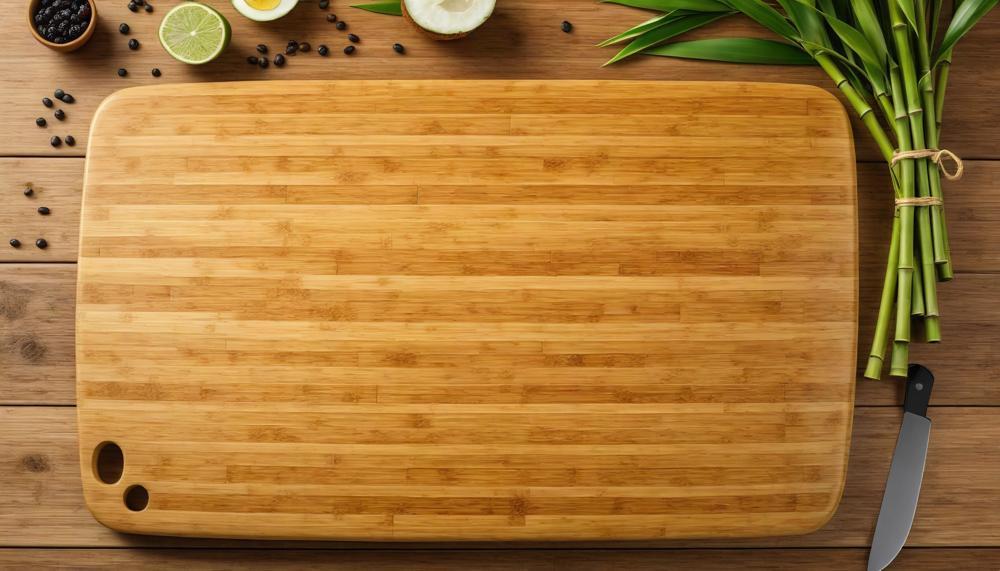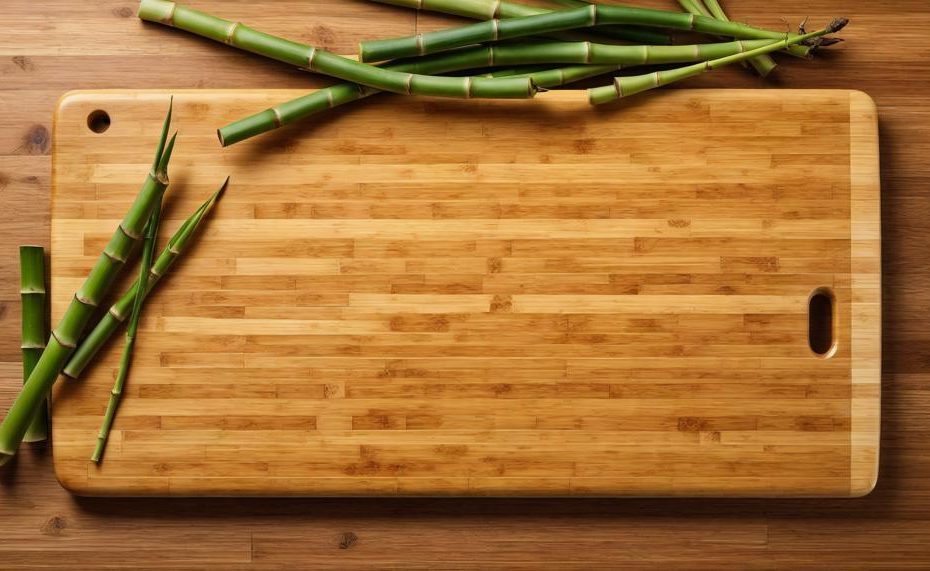Bamboo cutting boards are a kitchen staple for their durability and eco-friendliness. However, to maximize their lifespan and maintain a safe food prep surface, they need a bit of TLC. Seasoning is a straightforward but crucial step that keeps your board in top shape. Here’s why it’s important and how to do it:
Why Season Your Bamboo Cutting Board?
- Prevents Cracking and Warping: Bamboo naturally expands and contracts with moisture. Seasoning helps stabilize the board and prevent splits.
- Repels Water and Bacteria: A well-seasoned board has a protective layer that keeps moisture out, reducing the risk of bacteria growth.
- Extends Longevity: Regular seasoning keeps your board looking great and functioning well for years.
How to Season Your Bamboo Cutting Board:
- Clean: Wash your board with warm soapy water and dry it thoroughly.
- Oil Selection: Use food-grade mineral oil or an alternative like coconut oil.
- Application: Apply a thin layer of oil, covering all surfaces, and let it soak in.
- Repeat if Necessary: For very dry boards, repeat the process until the wood stops absorbing oil.
Regular seasoning is simple and ensures your bamboo cutting board remains a reliable kitchen tool. Ready to give your board the care it needs? Let’s dive into the details.
Contents
Why Season a Bamboo Cutting Board?
Seasoning a bamboo cutting board provides multiple benefits that enhance its longevity and maintain its hygiene. Here are the primary reasons why seasoning is essential:
| Benefit | Explanation | Importance |
| Seals Pores | Seasoning seals the tiny pores in bamboo, preventing moisture from entering and causing the board to crack or warp. | Prevents structural damage, extending the board’s lifespan. |
| Enhances Durability | A seasoned cutting board is more resistant to daily wear and tear, ensuring it remains functional for a longer period. | Makes the board more robust and long-lasting. |
| Improves Appearance | Applying oil gives the bamboo a rich, shiny finish, making it look more appealing and well-maintained. | Maintains an attractive look, enhancing your kitchen’s aesthetics. |
| Prevents Bacteria Growth | Seasoning creates a protective barrier that reduces the risk of bacteria thriving in the wood’s crevices. | Ensures a safer and more hygienic food preparation surface. |
| Regular Maintenance | Seasoning is part of regular care that keeps the cutting board in optimal condition, preventing it from becoming dry and brittle. | Maintains the board’s performance and safety over time. |
How Often Should You Season a Bamboo Cutting Board?
For those who use their bamboo cutting board frequently, seasoning it once a month is ideal. If your board sees lighter use, every 3-4 months should suffice. The key is to keep an eye out for signs of dryness or cracking, which signal the need for an oil treatment.
Importance of Seasoning Your Bamboo Cutting Board
Seasoning a bamboo cutting board is more than just a maintenance task; it’s essential for several reasons:
Preventing Dryness and Cracking
Bamboo, a natural material, can dry out and crack without proper care. Regular seasoning helps maintain moisture, preventing warping and extending the board’s lifespan.
Creating a Protective Barrier
When you season the board, you form a protective layer that shields against tiny grooves and scratches caused by knife cuts. This barrier is crucial for hygiene, as it prevents bacteria from thriving in these crevices.
Odor and Stain Resistance
Bamboo is porous and can absorb strong odors from foods like onions and garlic. Seasoning helps create a barrier that prevents these smells and also protects against stains from colorful foods like berries.
Enhanced Durability and Appearance
Regular seasoning keeps the board looking new and maintains its smooth surface, making it a pleasure to use in your kitchen.
Materials You’ll Need
Properly seasoning your bamboo cutting board is essential to ensure its longevity, maintain hygiene, and protect against stains and bacteria. The necessary materials for this process are straightforward but must be chosen carefully.
| Material | Description | Purpose |
| Mineral Oil | Colourless and odourless oil that is food-safe and does not turn rancid. | Seals the bamboo surface to prevent water and bacteria penetration. |
| Beeswax | Natural wax that provides a protective, water-resistant layer. | Adds shine and creates a barrier against moisture and bacteria. |
| Coconut Oil | Natural oil with antifungal and antibacterial properties. | Prevents bacterial growth and is suitable for high-temperature use. |
| Lemon Juice | Acidic juice used as a natural cleaning agent. | Cleans the surface before applying oils by removing dirt and bacteria. |
| Clean Cloth or Paper Towels | Soft, lint-free cloths or absorbent paper towels. | Used for applying and spreading the oils evenly across the board. |
| Bowl or Container | A small, clean bowl or container. | Used for mixing oils if combining different types. |
Instructions:
- Clean the Board: Before seasoning, use lemon juice to clean the bamboo cutting board thoroughly. Wipe with a damp cloth and let it dry completely.
- Apply the Oil: Using a clean cloth or paper towel, apply a generous amount of mineral oil or your preferred oil to the surface. Rub in circular motions to ensure even coverage.
- Let it Soak: Allow the oil to penetrate the bamboo for at least 20 minutes. For deeper conditioning, let it sit overnight.
- Remove Excess Oil: Wipe off any excess oil with a clean cloth.
- Optional Beeswax Finish: If using beeswax, apply it after the oil has soaked in. Rub a small amount of melted beeswax onto the surface for added protection and shine.
Regular maintenance using these materials will keep your bamboo cutting board in prime condition, enhancing its durability and performance in your kitchen.
Step-by-Step Seasoning Instructions
To keep your bamboo cutting board in top shape, follow these detailed steps for seasoning:
| Step | Description | Tips |
| Clean the Board | Wash with warm water and soap. Rinse and dry thoroughly. | Ensure the board is completely dry before oiling. |
| Choose the Right Oil | Select food-grade mineral oil. | Avoid oils that can turn rancid. |
| Apply the Oil | Pour oil and spread evenly. | Use a clean cloth or paper towel. |
| Let It Soak | Allow the oil to soak in for 20 minutes or overnight. | Longer soak for deeper conditioning. |
| Wipe Off Excess | Remove excess oil and buff the surface. | Ensure no oil remains on the surface. |
| Repeat | Reapply oil 2-3 times initially, then monthly. | Adjust based on usage frequency. |
Additional Tips
- Storage: Keep the board in a dry place to prevent moisture absorption.
- Maintenance: Avoid soaking in water and direct sunlight exposure.
- Hygiene: Regularly inspect for cracks or deep cuts and replace if necessary.
Additional Tips for Seasoning
Seasoning Frequency for Bamboo Cutting Boards
A bamboo cutting board should be seasoned every 3-4 months. The exact frequency depends on how often the board is used and the type of tasks it handles. For daily use or heavy-duty tasks, seasoning might be required more often.
Signs Your Bamboo Cutting Board Needs Reseasoning
| Signs | Description | Action |
| Dryness and Dullness | The surface appears dry, dull, or starts developing small cracks. | Reseason immediately to prevent further damage. |
| Water Absorption | Water no longer beads on the surface and is absorbed instead. | Apply a fresh coat of oil to restore the protective layer. |
| Strong Odors | The board emits strong or unpleasant smells, indicating trapped food particles and bacteria. | Clean thoroughly and reseason to seal cracks and pores. |
Regular seasoning ensures your bamboo cutting board remains durable and safe for food preparation.
When to Replace a Bamboo Cutting Board
A bamboo cutting board should typically be replaced every 1-3 years, depending on the frequency of use and care. Proper maintenance can extend its lifespan, but certain signs indicate it’s time for a new one.
Signs Your Bamboo Cutting Board Needs Replacement

| Sign | Description | Action |
| Visible Wear and Tear | Noticeable damage such as cracks, chips, or splitting. | Replace to prevent bacteria buildup and contamination. |
| Deep Grooves or Scratches | Deep cuts that are hard to clean and can harbor bacteria. | Consider a new board to ensure food safety. |
| Unpleasant Odor | Persistent smell even after thorough cleaning. | Replace, as lingering odors can indicate bacterial growth. |
| Discoloration | Significant color changes that do not come off with cleaning. | Time for a new board, as discoloration can indicate deep contamination. |
Proper care, such as regular seasoning and thorough cleaning, can help extend the life of your bamboo cutting board. However, once these signs appear, it’s best to replace the board to maintain a safe and hygienic kitchen environment.
Conclusion
Seasoning a bamboo cutting board is essential to keep it in prime condition, offering both practical and aesthetic benefits. This straightforward maintenance routine transforms your board into a long-lasting, bacteria-resistant kitchen tool.
Regularly applying food-grade mineral oil or coconut oil creates a protective barrier, preventing moisture from seeping in and causing cracks or warping. This not only enhances the durability of your board but also ensures a safe and hygienic food preparation surface. A well-seasoned board repels water and bacteria, making it a healthier choice for your kitchen.
To begin, thoroughly clean and dry your board. Then, apply a thin layer of oil, covering all surfaces, and allow it to soak in. For very dry boards, repeat until the oil is no longer absorbed.
By incorporating this simple habit into your routine, you’ll preserve the beauty and functionality of your bamboo cutting board, ensuring it remains a reliable kitchen companion for years to come.





